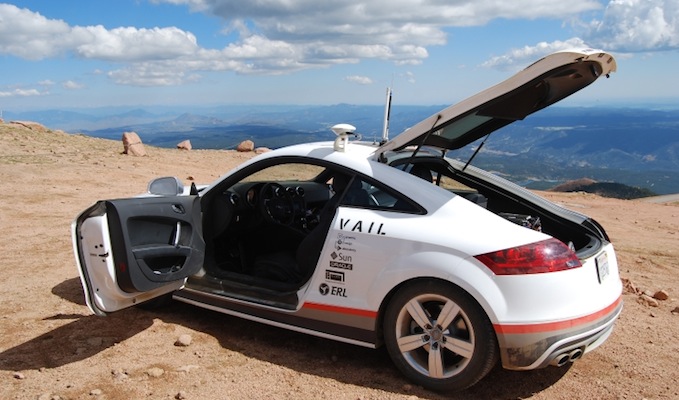Engineering students have been hard at work on an autonomous car that they hope will lead to safer driving systems in the future.
Led by Chris Gerdes, professor of mechanical engineering and director of the Center for Automotive Research at Stanford (CARS), the students have spent the last several years modifying and retrofitting an Audi TT-S — named Shelley — with an autonomous driving system. To put Shelley to the test, Gerdes and his students take the car to Thunderhill Raceway in Willows, CA, a three-hour drive north of Stanford.
Given how fast Shelley can drive, however, it could be closer to two hours. On the raceway, Shelley can hit speeds of over 110 mph, but the car typically paces itself at 50 to 75 mph — the speed at which most car accidents happen.
“A race car driver can use all of a car’s functionality to drive fast,” said Gerdes. “We want to access that same functionality to make driving safer.”
Shelley’s functionality, according to Gerdes, includes its throttle, its brakes and the friction between its tires and the road. Understanding how Shelley can adjust and account for all of those factors helps improve the algorithms that help Shelley run, and can lead to the development of an automatic collision avoidance software in self-driving cars such as Google’s.
Following a successful lap, the students analyze Shelley’s performance, paying attention to which sections of the track gave the car trouble as well as the braking and accelerating forces the car weathered along the way. Some students factor artificial intelligence and learning into their assessments, whereas others ask how the algorithms will take the behaviors of drivers into account.
In the future, autonomous cars such as Shelley may be able to operate in tandem with their drivers and, in situations that may result in an accident, choose between emergency maneuvers such as braking or changing lanes.
Gerdes said that his students — several of whom have gone on to continue their work in the auto industry — conduct themselves like a “race team” on testing days, scheduling which tests to subject Shelley to.
“Once you get to the track, things can go differently from what you expect,” Gerdes said. “So it’s an excellent lesson of advanced planning, but also how to come together as a team and deal with changing priorities.”
Contact Jacob Nierenberg at jhn17 ‘at’ stanford.edu.
